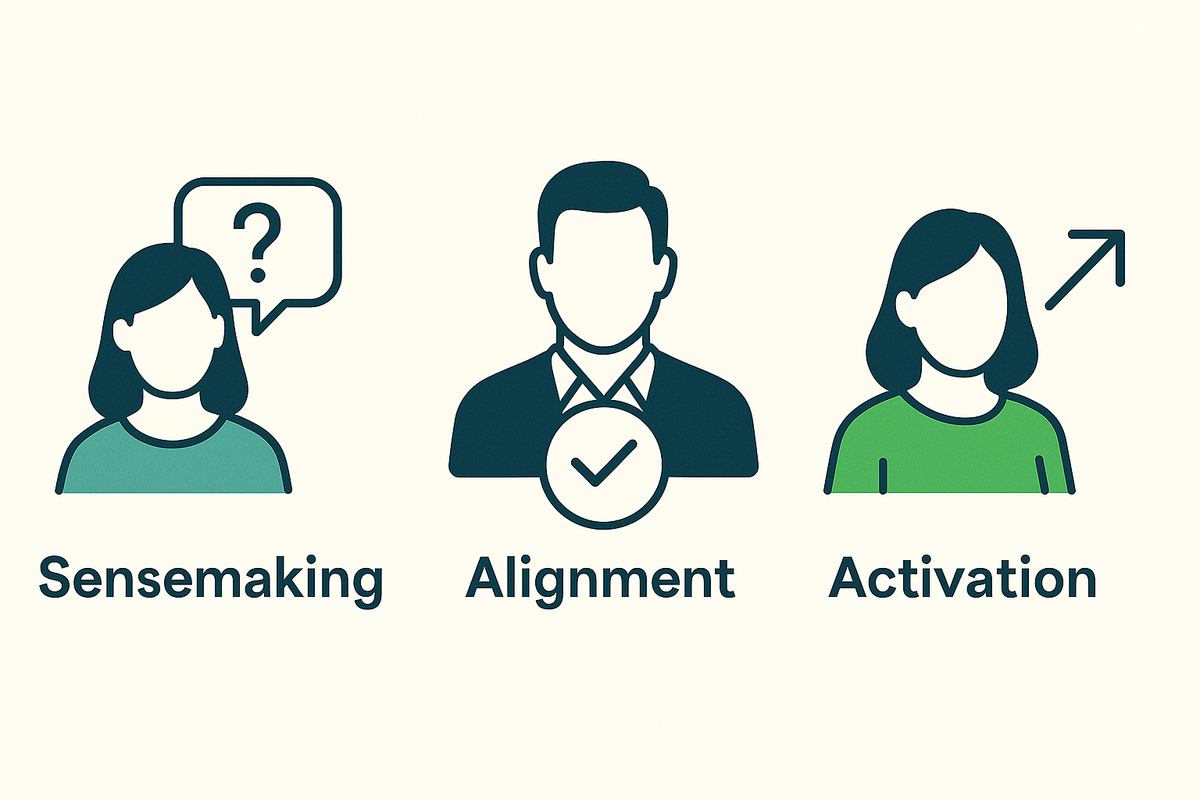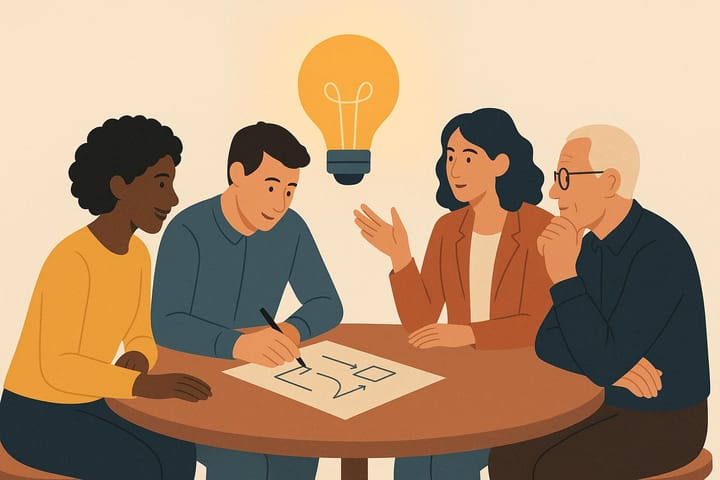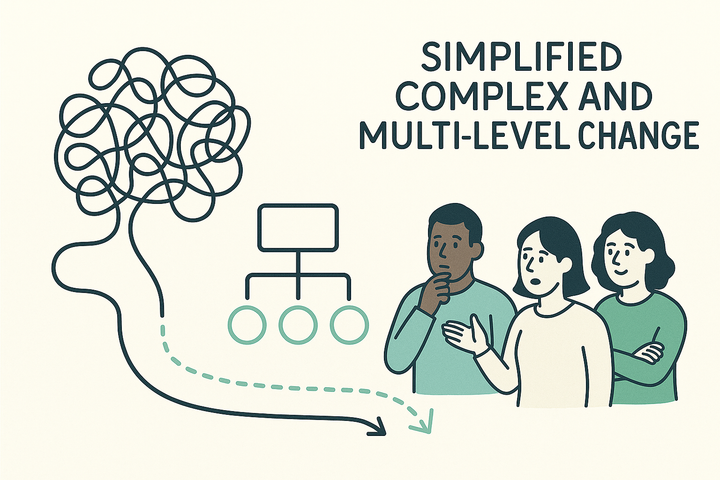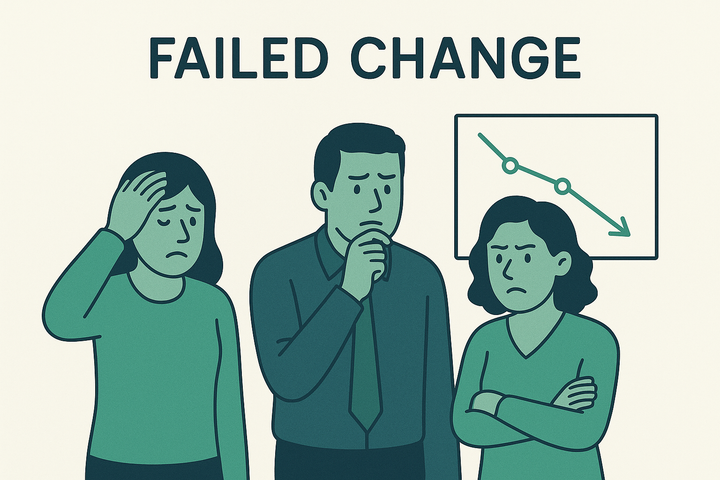How Change Happens
Change doesn’t happen because it’s announced. It happens when people understand, align and act — together. Here’s how to layer your communication so change actually moves through the organisation.

Change isn’t declared. It’s built.
Here’s the uncomfortable truth: most change programmes are designed from the top — but experienced everywhere else.
The strategy gets signed off. The transformation programme is named. The comms team gets asked to “land the message.”
But change doesn’t happen because it was approved. Or announced.
It happens because people — across the organisation — hear it, understand it, believe it, and then do something differently.
That’s the real work. And it’s the work that’s most often skipped.
The anatomy of change
Change is not a campaign. It’s a layered movement. And to get that movement, three things need to happen — in sequence and with deliberate care:
- Sensemaking: people need to understand what’s happening, and why
- Alignment: leaders, managers and teams need to believe in it — and feel prepared
- Activation: people need to know what to do next — and feel supported in doing it
You’ve seen these before — they’re the core of the Sensemaking–Alignment–Activation model we outlined here.
But what does that actually look like when change is moving?
Phase 1: Sensemaking – “Why is this happening?”
People don’t take action because you tell them to.
They take action when something makes sense — emotionally, intellectually, culturally.
That means your change comms can’t start with the “what.”
It has to start with the why, and be positioned in a way that connects to:
- The external environment
- Organisational context
- Past promises and future risks
- What people are already worried about or hoping for
This is where the narrative begins — and why creating a strategic change narrative matters so much.
At this stage, your communication should:
- Frame the drivers of change clearly
- Avoid sugar-coating or over-justifying
- Honour past work and effort
- Acknowledge the unknowns
- Make the big picture feel personal
You are not selling the change. You’re giving people the tools to make sense of it.
Phase 2: Alignment – “What does this mean for us?”
Once the why is clear, people ask:
“What does this mean for me, for my team, for how we work?”
This is where most change programmes start to wobble — because alignment doesn’t happen by accident.
It has to be built. Layer by layer.
That means:
- Leaders are aligned in both message and tone
- Managers are armed to brief, guide and support their teams (see this piece)
- Staff have heard the message more than once, from more than one source
- Confusion and questions are not seen as resistance — but as part of the journey
Alignment isn’t one briefing. It’s a rhythm of repetition, clarification, and consistency across levels. It lives in:
- Language (is it consistent?)
- Behaviour (is it mirrored by leaders?)
- Systems (are goals and incentives aligned?)
- Feedback (are people heard, and are messages adjusted?)
You don’t move to activation until you’ve built alignment.
Phase 3: Activation – “What do I need to do differently?”
This is the part most leaders want to jump to: action.
But unless sensemaking and alignment are in place, “activation” doesn’t stick. You get lip service, confusion or quiet workarounds.
Real behavioural activation requires:
- Clarity: What’s expected of me now?
- Confidence: Do I feel supported in doing this?
- Consistency: Are the people around me moving too?
- Credibility: Do I trust the leadership to back this?
- Visibility: Am I seeing others act, and learning from them?
This is where targeted calls to action, feedback loops, rituals, reinforcement and measurement all matter.
It’s also where change becomes reality.
The feedback loop that holds it together
Change is not a straight line. People don’t move in lockstep.
That’s why every phase must include strong feedback loops — not as a gesture, but as a guide.
You need to:
- Sense what people are hearing (not just what you said)
- Track where the message is landing — and where it’s breaking
- Identify which teams or leaders are aligned — and which are drifting
- Spot early behaviours that signal traction — or resistance
Without feedback, you’re not leading change. You’re hoping for it.
Why this matters now
This isn’t just a nice model. It’s survival infrastructure for what’s coming next.
Every organisation is about to be — or already is — in a period of disruptive transformation, driven by AI, workforce shifts, and systemic risk. Job roles are changing. Power is shifting. Workflows are being rebuilt in real time.
In that context, change isn’t a project. It’s a constant condition.
And if we want to lead through that with clarity, humanity and pace, we need comms systems that do more than inform. We need ones that help people move — together.
Final thought
Change doesn’t happen because you’ve decided it. Or because the programme has launched.
It happens when:
- The message makes sense
- The people are aligned
- The actions feel doable
- And the system learns as it goes
If you’re not building your comms plan on that foundation — you’re building it on hope.
Want help mapping how change actually moves through your organisation?
Start with the Sound & Signal Review — our diagnostic that shows you where the story breaks down, what’s missing from your alignment strategy, and how to close the gap between message and movement.
Or, if you’re already in motion and feeling stuck, the Rapid Action Accelerator can help you reboot momentum — fast.



